Artist Interview: Judith Kruger
Judith Kruger is an American abstract painter whose work focuses on the Human-Environment connection. She manipulates globally sourced natural matter “as paint”. Her contemporary practice re-contextualizes the ancient processes of Nihonga, traditional Japanese mineral pigment painting (Nihon translates as Japan, and ga as painting, literally “Japanese-style paintings”). She received her BFA from Syracuse University and her MFA from Savannah College of Art and Design. Her work has been exhibited in galleries and museums throughout the United States and Japan.
Sherry Saunders: How did you begin to learn Nihonga? What drew you to learn this approach?
Judith Kruger: I actually was in Kyoto in 2001 and visited a gallery showing some interesting Nihonga. The artist was present and escorted me to the pigment shop of Saiundo Fujimoto. Mr. Fujimoto spent a considerable amount of time introducing the materials. It was amazing to me that Nihonga had never worked its way into the Western fine arts educational system. Its elusiveness and exoticism was very intriguing.
SS: Did you start by working traditionally before you began to seek your own individual approach to this style of painting?
JK: Of course, like any new art form, I had to learn the basics. It took years of scouring for information, international travel for research, practice and refinement before being free to conceptually articulate. My prior traditional training in drawing and painting was adaptable to some extent. At that time I was developing ceramic collections in European and Asian factories so it was common practice for me to want to know how, why and where something was made. My obsession with alchemic processes was honed long before the Nihonga immersion. Lately, I am painting with pigment from rocks that I’ve had since grade school. One starts to wonder about destiny.
The painting Taisha Dance employs pulverized limonite that I acquired in Cyprus in the late 80s. In 2007, while staying with a Nihonga professor in Tokyo who had a pigment-manufacturing lab in his home, we made pigment from Taj Mahal rocks procured during a past research trip to India. I have never considered Nihonga apart from its remarkable material.
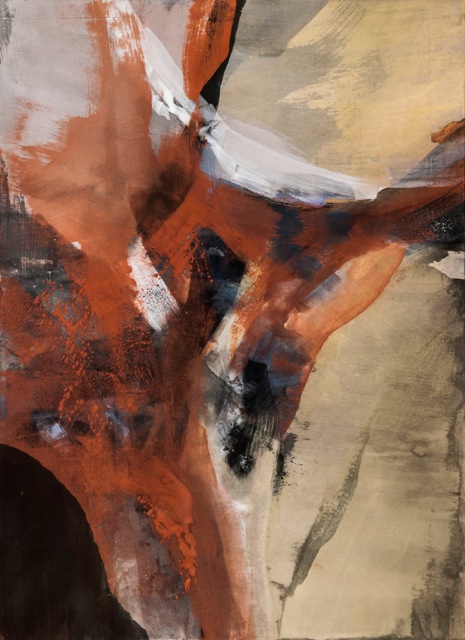
Judith Kruger, Taisha Dance, 2012, Chinese ochre, Japanese ochre, limonite, quartz, lapis, obsidian, pure silver leaf, patina, oyster shell, sumi on Kumohada paper on canvas, 58 x 42 inches © Judith Mosse Kruger, courtesy of Morrison Gallery
SS: Can you describe your individual approach to Nihonga?
JK: From the get-go, my primary concern was in pushing the medium into abstraction. I never intended to render cherry blossoms and bamboo. My approach to Nihonga has always been to view its rich history and practice as a means to an end, rather than an end. Old master works offer sensitive handwork and techniques as research for contemporary painting rather than for iconic imagery or concept. Rustic weathering and destruction interests me as much, if not more, than new and pristine: even better when there is a juxtaposition of two opposing surfaces within a given painting. This dichotomy pushes the works ambiguity. I define my work as abstract rather than non-representational, because it is loaded with content even though the narrative is intentionally open-ended for the viewer’s input.
Most people do not realize that traditional Japanese screens and scrolls employ layered pulverized semi-precious minerals, plants, earth, shells and insect secretions as paint. This was the modus operandi since the prehistoric era before commercial paint became available. Nihonga paintings are often labeled as being flat. I agree from the aspect of a flattened picture plane and disagree when it comes to its potential for inner depth. Conservators are generally the only Westerners I have spoken with who dissect the actual matter employed in painting the way I do.
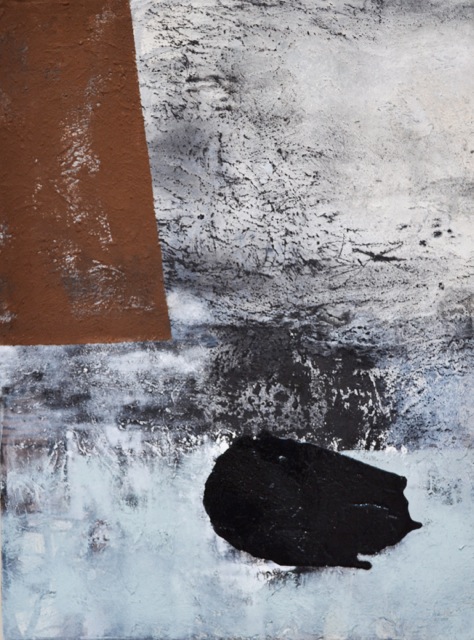
Judith Kruger, Inland-Outland 4, 2013, Cyprian Umber, white malachite, charcoal, marble powder, washi fiber on panel, 40 x 30 inches © Judith Mosse Kruger, photo courtesy of Morrison Gallery
Nihonga, to me is ritualistic, alchemic and catalytic. Visitors enter my studio and immediately liken it to a chemistry lab. The scientific process is paramount to my painting. Outside of the studio, I am always investigating. Inside the studio, the act of working and experimenting dictates the works’ direction. It’s a constant balancing act between chance, discovery and intention. In Inland-Outland 4, for example, a mixture of black carbon pigment and natural resin was puddled over a malachite and oyster shell-painted dimensional surface, made of fine layers of handmade Japanese paper. It’s like cooking. Less is always more but often it needs something over the top to bring out its essence. My approach to Nihonga is mindfully archival yet uniquely hybrid.
SS: How does it vary from the way other artists are influenced by Eastern art traditions?
JK: Looking East is not a new concept. Think of James Whistler, Mary Cassatt, Morris Graves, Mark Tobey, Arthur Dove, Ad Reinhardt, Agnes Martin, John Cage, Brice Marden, Sam Francis, Sigmar Polke and on and on… My specific practice revolves around alchemy. I come face to face with Nihonga more so from the perspective of a potter or chemist than a painter. The visceral qualities of shino glazes on Japanese tea ceremony vessels, the ink’s subtle tonal shifts in Tohaku’s delicate pine tree paintings and the matter-marked chance-induced works of Shimamoto, Yoshihara and the post-war Gutai group influence me equally. I live by the ritualistic practice of Nihonga, so for me the East is not only significant for influence, but also for methodology.
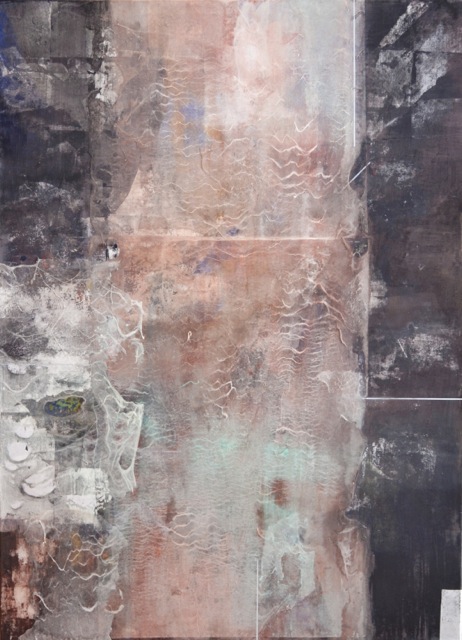
Judith Kruger, Inland-Outland: Mapping Mountains 3, 2013, malachite, cinnabar, Japanese ochre, oyster shell, marble dust, carbon, gesso, pure silver, and scrubbed washi on Kumohada paper on canvas, 58 x 42 inches © Judith Mosse Kruger, photo courtesy of Morrison Gallery
SS: Can you tell me why abstraction is an important element in your work?
JK: I respond to encounters, not objects and likewise, [I] want the viewer to profoundly encounter the work. Easily definable, representational objects or subject matter would pull the viewer away from the work’s sensual attributes. Hopefully, I’ve provided just enough and not too much food for thought. Actually, in the context of the contemporary art world, I find myself having to defend Nihonga’s historical value for post-modernism much more than abstraction. Representation, to me, often seems to be too obvious a solution for conveying my ideas.
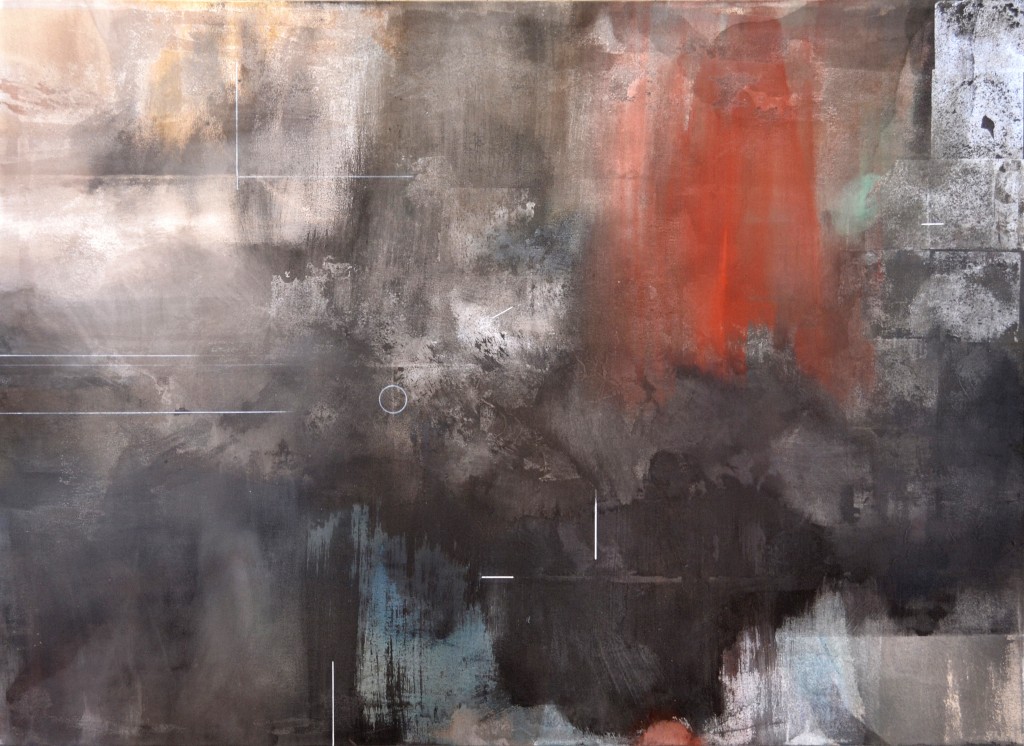
Judith Kruger, Inland-Outland: Mapping Mountains 2, 2013,obsidian, vermillion, iron oxide, malachite, indigo, oyster shell, ochre, sumi, silver leaf on canvas, 42 x 58 inches © Judith Mosse Kruger, photo courtesy of Morrison Gallery
SS: How is your work evolving today? Describe the new work you are creating.
JK: Currently, in my Connecticut studio, I am continuing the Inland-Outland works, which began in Georgia, now focusing on mountainous structures, rather than marsh DNA. Basically, I’m articulating new territory though a combination of expressionistic painting and structural line work. I started using elements of mapping as a formal connecting and structuring device after seeing some intricate Japanese cosmology maps. Incidentally, I’ve never liked using maps. I’d just as soon get lost. Maybe I’m trying to lead or even mislead the viewer into areas of the work that they may not have discovered without these intentional marks.
I’m also sketching and photographing the massive trees that surround the studio. The work reminds me of a time in Savannah when I was abstracting bamboo stalks with hide-glue soaked pieces of charcoal over malachite and cinnabar soaked paper. It was my version of painting bamboo, today, as an American abstract painter without the constraints of Japanese lineage.
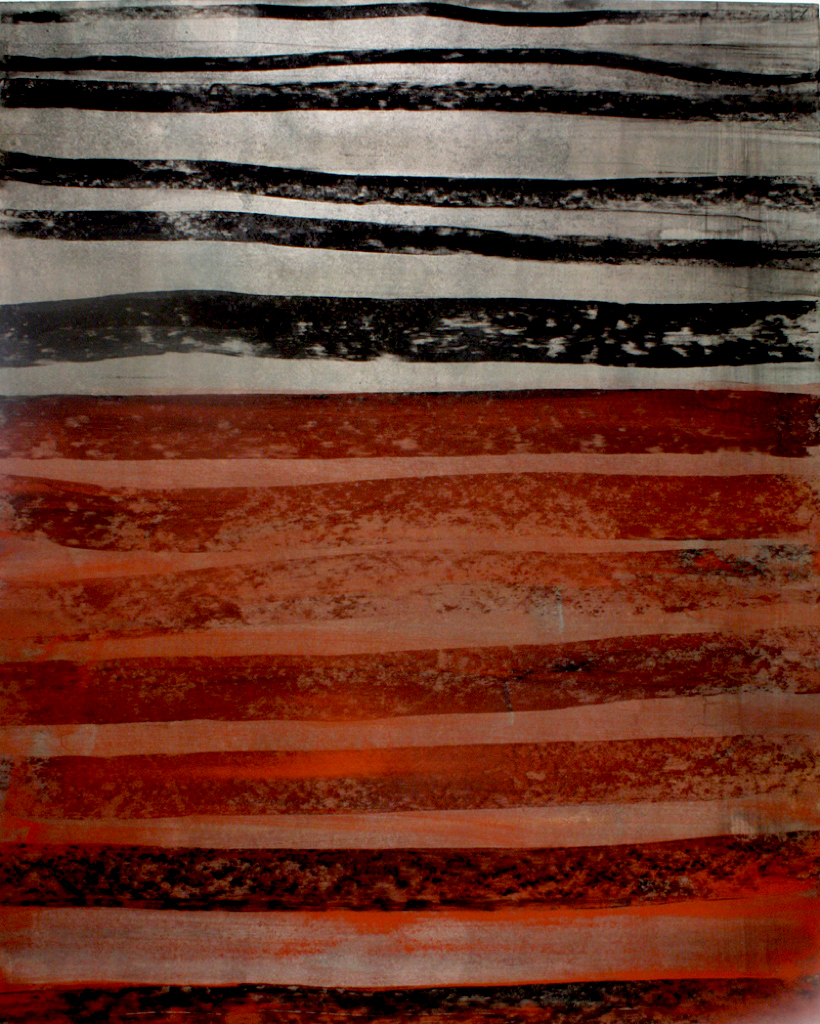
Judith Kruger, Bamboo Strata, 2010, charred malachite, sumi, cinnabar, charcoal on Kumohada paper on panel, 45 x 36 inches © Judith Mosse Kruger, photo courtesy of Morrison Gallery
I’ve begun an ongoing series of Inland-Outland monotypes. The first grouping ties together inorganic and organic gestures and structures…water and rocks, nature and human nature. Some of the work is hand-manipulated after printing with indigo and Japanese metallic leaf. I’m painting on large metal plates with ink. Nihonga is an active catalyst: a signifier, not the medium itself.

Judith Kruger, Marking the Spot, 2012, monotype, 42.5 x 30 inches © Judith Mosse Kruger, collection of the artist
SS: What are your long-term goals for your work?
JK: I hope to revisit Japan in 2014, this time for an extended stay to continue my research and to paint. The work is getting larger and more significant. I’m taking greater risks and it’s all moving forward.
Judith Kruger’s new paintings will be featured this summer in Chicago in a three-person show at Perimeter Gallery, July 19-August 30, 2013. Her work is also available through Morrison Gallery, Kent, CT and Bentley Gallery, in Phoenix, Arizona.
Sherry Saunders is an Assistant Professor of Graphic Design at Lamar University in Beaumont, TX. View her work here.
